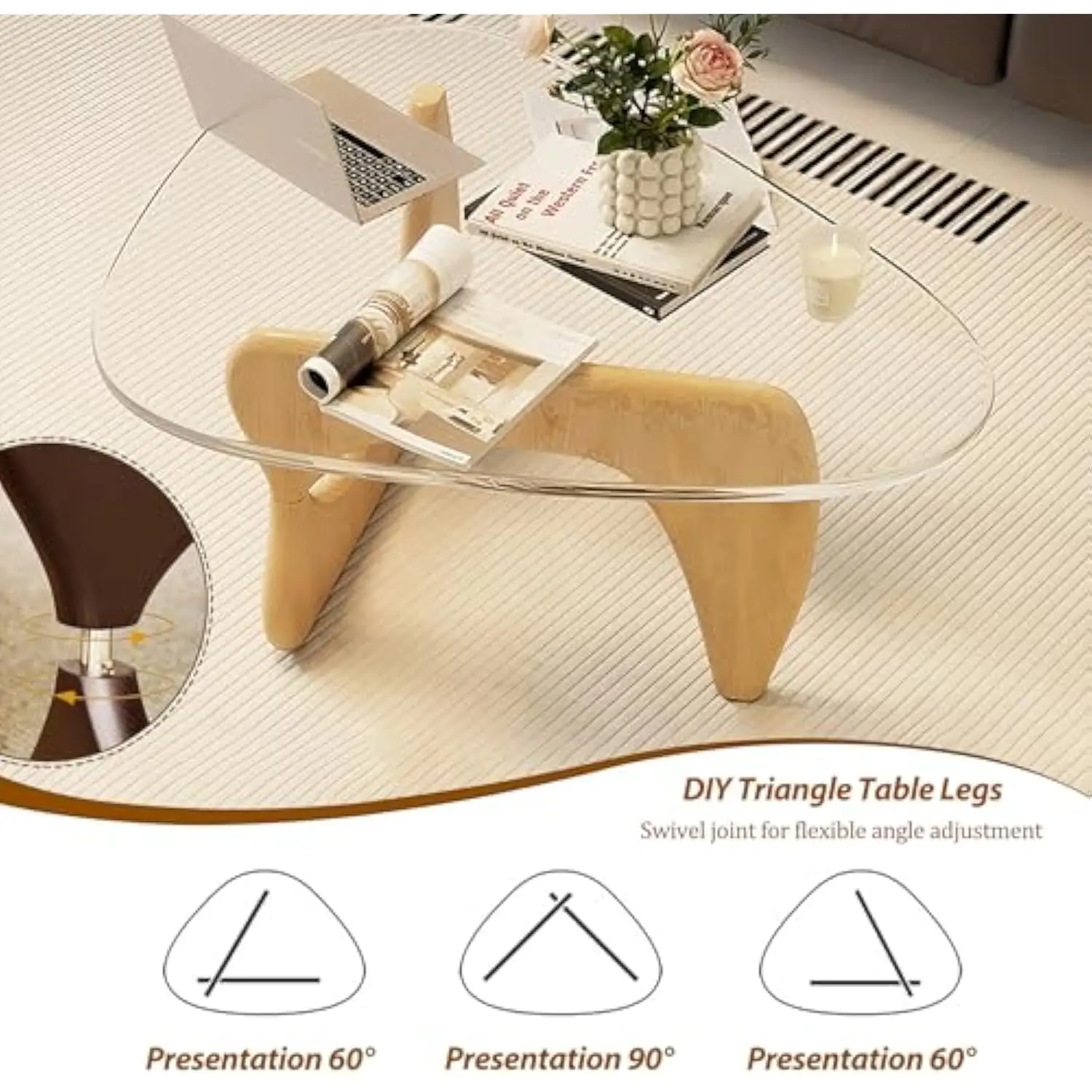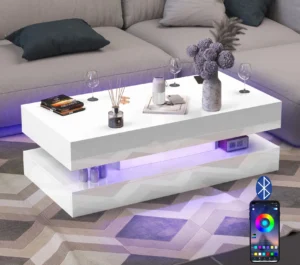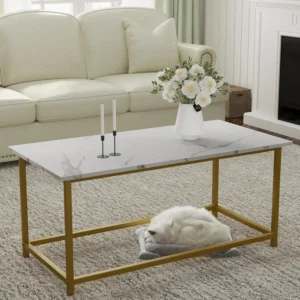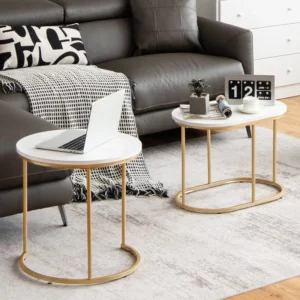The Timeless Appeal of Glass Top Mid-Century Coffee Tables
The mid-century modern movement gave us some of the most enduring furniture designs we still cherish today. Characterized by clean lines, organic forms, and an unwavering commitment to functionality, mid-century coffee tables stand as centerpieces in thoughtfully designed living spaces. Glass top versions offer a unique twist on this classic style, adding a touch of visual lightness that perfectly complements the sometimes heavier wooden elements typical of this design era.
What makes these tables particularly special is how they honor mid-century principles while creating an airy, expansive feel. The transparent surface seems to float, making even smaller rooms feel more spacious while still anchoring the seating arrangement. This visual lightness presents both opportunities and challenges when it comes to styling—how do you balance form and function on a see-through surface?
The popularity of mid-century design has remained remarkably consistent since its emergence in the 1940s through 1960s, proving that good design truly is timeless. Today’s glass top coffee table ideas seamlessly blend vintage appeal with contemporary sensibilities, making them versatile additions to almost any living space.
In this guide, we’ll explore expert strategies for styling your mid-century modern glass top coffee table to achieve that perfect balance of beauty and functionality that defines the era.
Understanding Mid-Century Modern Aesthetic Fundamentals
Before diving into specific styling techniques, it’s essential to understand the design principles that define authentic mid-century modern style. These fundamentals will guide all your coffee table styling decisions:
- Clean lines and organic curves: Mid-century design balances straight edges with gentle, nature-inspired curves
- Form follows function: Every element serves a purpose—purely decorative flourishes take a back seat to functional design
- Material integration: The thoughtful combination of natural and manufactured materials creates visual interest
- Balanced minimalism: Spaces should feel uncluttered yet warm, avoiding both stark emptiness and overwhelming busyness
The materials that harmonize best with glass in mid-century design include warm woods like walnut and teak, metals such as brass and chrome, and organic materials like leather and ceramics. Color palettes typically feature neutral backgrounds punctuated by strategic pops of color—think mustard yellow, teal blue, rusty orange, or olive green.
In authentic mid-century spaces, the coffee table isn’t just furniture—it’s a focal point where function and beauty converge. Design pioneers like Isamu Noguchi and Charles and Ray Eames understood this, creating tables that were practical surfaces for daily life while doubling as sculptural art pieces.
Modern interpretations maintain these core values while adapting to contemporary needs. The best functional mid-century lift top coffee tables demonstrate this evolution, as do the continued popularity of mid-century modern teak coffee tables that showcase the era’s signature materials.
Glass Surface Styling Considerations: Opportunities and Challenges
Glass top coffee tables offer unique advantages that savvy designers know how to leverage:
Styling Opportunities
Glass surfaces create an impression of visual lightness that’s particularly valuable in smaller spaces or rooms with limited natural light. They allow beautiful flooring or statement rugs to remain visible, essentially providing an additional display dimension. The reflective quality of glass also helps bounce light around the room, creating a brighter, more open feel.
Perhaps most interesting is how objects placed on glass appear to float, creating a sense of weightlessness that can make even substantial decorative items feel less imposing. This floating effect adds a touch of sophistication and visual interest impossible to achieve with solid-top tables.
Practical Challenges
Despite these advantages, glass surfaces present several practical considerations. Fingerprints and dust become immediately visible, requiring more frequent cleaning than other materials. Items can slide across smooth glass surfaces, especially in homes with children or pets. Without thoughtful styling, glass tables might sometimes create a cold, sterile appearance that contradicts the warmth central to mid-century design.
Protection against scratches and damage is another key concern, requiring preventative measures to maintain the table’s pristine appearance. Many homeowners wonder about the differences between material options, and understanding glass vs. wood coffee tables can help inform both styling and maintenance decisions.
For families with young children or active households, incorporating glass coffee table safety tips into your styling approach ensures both beauty and practicality.
Essential Balance Principles for Glass Table Layouts
Visual Weight Distribution
Creating harmonious arrangements on glass coffee tables requires careful attention to visual weight—how heavy or substantial items appear. Unlike solid tables where objects simply sit on top, glass creates the illusion that items are floating, magnifying any imbalance in your arrangement.
Distribute heavier-looking pieces (like large books or substantial sculptures) throughout your arrangement rather than clustering them on one side. You don’t need perfect symmetry—in fact, slightly asymmetrical arrangements often look more natural—but the overall impression should feel balanced when viewed from typical seating positions.
Consider the table’s size when selecting items; oversized objects can overwhelm smaller tables, while tiny accessories may look lost on larger surfaces. Aim for a primary focal point with supporting elements of varying visual weights.
The Strategic Use of Negative Space
When styling glass surfaces, remembering that “less is more” becomes particularly important. The transparency of glass makes empty space an active design element rather than just background. This negative space allows the eye to rest and prevents the arrangement from feeling cluttered or chaotic.
Intentionally leave portions of the table empty to highlight your carefully chosen pieces. This restraint is especially important for transparent surfaces, where too many items can create visual noise and diminish the table’s elegant floating effect.
Height Variation and Layering
Creating visual interest through varied heights transforms flat arrangements into dynamic compositions. Include items of different heights—perhaps a taller candlestick or vase alongside medium-height books and lower decorative boxes or trays.
On glass tables, effective layering requires special consideration. Since items can be viewed from all angles (including from below), ensure decorative pieces look attractive from multiple perspectives. Take care not to block sightlines across the room, especially in conversation areas where visual connection between people is important.
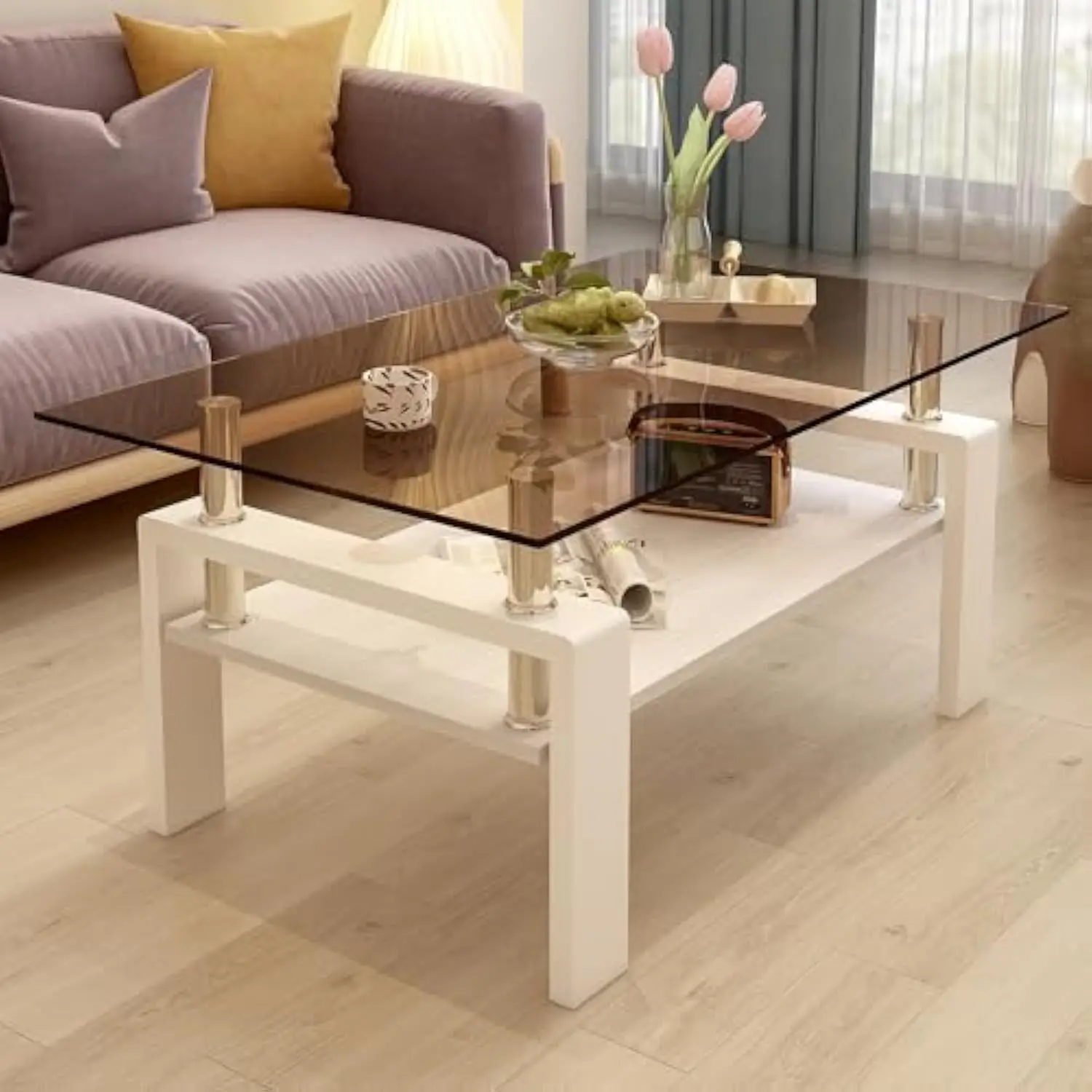
The principles of balance apply regardless of table shape, though you might need to adapt your approach for different forms like rectangular coffee tables. Learning advanced techniques for styling glass top coffee tables helps you master these fundamentals.
Practical Styling Techniques for Glass Top Tables
The Rule of Three (and Odd Numbers)
One of the most reliable styling techniques is arranging items in groups of odd numbers, particularly threes. This approach creates visual harmony that feels both intentional and naturally balanced. For larger tables, you might use multiple groupings of three, while smaller tables might benefit from a single trio or even just one statement piece.
When applying this rule, consider how items relate to each other. Group objects that share a common element—perhaps similar colors, complementary functions, or related materials—while maintaining some variety in height, texture, or shape.
Examples of effective trios include:
– A medium-sized plant, a stack of two books, and a small decorative object
– A low tray with two complementary items positioned nearby
– Three varied ceramic or sculptural pieces of different heights
Anchor Elements and Zoning
Creating defined areas on your glass coffee table prevents items from appearing randomly scattered. Use trays, books, or decorative mats as anchors that visually group smaller items together. These anchors are particularly important on glass surfaces where objects might otherwise seem to float disconnectedly.
Materials that beautifully complement glass include:
– Warm woods (walnut, teak, oak)
– Natural fibers (woven baskets, rattan, jute)
– Metals with character (brass, copper, bronze)
– Leather or suede
Try creating mini-vignettes within your overall arrangement—perhaps a small collection of vintage items in one zone and functional everyday pieces in another. This zoning creates visual interest while keeping the table organized.
Symmetrical vs. Asymmetrical Approaches
Both symmetrical and asymmetrical arrangements can work beautifully on glass coffee tables, each creating a different feeling in your space.
Symmetrical layouts, where items are mirrored on either side of a central axis, create formal, balanced looks that impart a sense of order and intentionality. This approach works particularly well in more traditional spaces or with rectangular tables.
Asymmetrical arrangements feel more relaxed and organic, often creating more visual interest. The key to successful asymmetrical styling is ensuring the visual weight remains balanced even when the actual objects differ. Create a focal point that draws the eye, then arrange supporting elements around it.
For inspiration on different arrangement styles, explore creative approaches to glass coffee table decor styling. Your table’s shape will influence which approach works best—round coffee tables often benefit from different techniques than rectangular ones.
Selecting Mid-Century Appropriate Decor Elements
Books and Print Materials
Books are styling workhorses for mid-century coffee tables, providing height, color, and personality. Choose art, architecture, or design books with covers that complement your color scheme. For authentic mid-century appeal, look for geometric patterns, abstract art, or vintage photography on covers.
Create stable, visually appealing stacks by:
– Limiting stacks to 3-5 books for balance
– Arranging by size with largest on bottom
– Using books as platforms for smaller decorative objects
– Selecting covers with colors that echo other elements in your room
Organic Elements and Greenery
Plants add life and organic texture to mid-century arrangements. Choose varieties that complement the era’s aesthetic sensibilities:
– Succulents in geometric planters
– Air plants in brass or ceramic holders
– Small architectural plants like snake plants or ZZ plants
– Simple cut stems in minimalist vases
The right planters are crucial—look for clean-lined ceramic vessels, brass containers, or wooden planters with tapered legs. Low-maintenance plants are ideal for coffee tables, as they require minimal care while enhancing your arrangement.
Sculptural Objects and Artistic Elements
Decorative objects should reflect mid-century aesthetic values through their form and materials. Look for:
– Abstract sculptural pieces with organic or geometric forms
– Ceramics in earthy tones or bold colors with minimal patterns
– Brass or walnut objects with clean lines
– Glass or crystal pieces with interesting shapes
Balance statement pieces with supporting elements—one larger sculptural object can anchor your arrangement while smaller complementary pieces create context.

Functional Items with Design Merit
The mid-century philosophy values objects that are both useful and beautiful. Include functional items that also serve decorative purposes:
– Wooden or brass coaster sets
– Decorative boxes that hide remotes or other small necessities
– Match strikers or unique candle holders
– Vintage-inspired desk accessories repurposed for the living room
When selecting these pieces, look for quality craftsmanship and authentic materials that echo the principles of mastering mid-century oval coffee table styling. Complementing your glass table with walnut accents creates an authentic mid-century feel.
Mid-Century Modern Solid Wood Coffee Tables, Mid-Century Modern Teak Coffee Tables
$879.95 Select options This product has multiple variants. The options may be chosen on the product pageMid-Century Modern Glass Top Coffee Tables, Mid-Century Modern Glass Top Side & End Tables
$460.58 Select options This product has multiple variants. The options may be chosen on the product pageMid-Century Modern Glass Top Coffee Tables, Mid-Century Modern Vintage Coffee Tables, Mid-Century Modern Vintage Side & End Tables
$725.36 Select options This product has multiple variants. The options may be chosen on the product pageMid-Century Modern Large Coffee Tables, Mid-Century Modern Rectangular Coffee Tables
$603.26 Select options This product has multiple variants. The options may be chosen on the product pageMid-Century Modern Marble Top Coffee Tables, Mid-Century Modern Rectangular Coffee Tables, Mid-Century Modern White Coffee Tables
Price range: $163.28 through $189.22 Select options This product has multiple variants. The options may be chosen on the product pageMid-Century Modern Nesting Coffee Tables, Mid-Century Modern Nesting Table Sets
$361.45 Select options This product has multiple variants. The options may be chosen on the product page
Glass Surface Protection and Maintenance Strategies
Protecting your glass coffee table ensures its beauty lasts for years while maintaining your carefully curated styling.
Preventative measures worth implementing include:
– Quality coasters under all beverages—look for cork-bottomed versions that won’t slide
– Felt bottoms on all decorative objects to prevent scratches
– Protective trays under frequently moved items or those with rough bottoms
– Placement away from high-traffic paths where people might bump into edges
Develop a simple maintenance routine:
– Daily: quick dust with a microfiber cloth
– Weekly: thorough cleaning with a glass-specific cleaner
– Monthly: check and replace felt protectors as needed
For best results, use ammonia-free glass cleaners and soft microfiber cloths rather than paper towels. For stubborn fingerprints, a solution of equal parts white vinegar and water works effectively without streaking.
Table size affects both styling and maintenance requirements—smaller coffee tables might need more frequent attention as they tend to become crowded more easily.
Creating Visual Cohesion with Room Elements
Your coffee table styling should feel connected to the broader design story in your room rather than existing as an isolated arrangement.
Create visual cohesion by:
– Echoing colors from your rug, artwork, or accent pillows in your table accessories
– Repeating materials found elsewhere in the room (if you have brass lamps, include brass elements on your table)
– Considering sightlines from each seating position to ensure the arrangement looks intentional from all angles
– Creating depth through relationships between the coffee table and nearby furniture
A well-styled coffee table complements rather than competes with other elements in the room. Pay special attention to how your arrangement looks alongside adjacent furniture like sofas, side tables, and chairs.
For glass coffee tables specifically in larger spaces, additional considerations come into play. Explore ideas for integrating glass coffee tables into open spaces to create harmony throughout your living area.
Seasonal Styling and Refreshing Your Layout
One advantage of thoughtful coffee table styling is the ability to refresh your look seasonally without major redesigns. By maintaining core pieces while swapping accent elements, you can keep your space feeling current and appropriate year-round.
For summer arrangements, emphasize:
– Lighter colors and natural textures
– Botanical elements like small potted succulents
– Crystal or glass objects that reflect light
– Minimalist, uncluttered arrangements
In fall, transition to:
– Warmer tones and richer textures
– Natural elements like small dried arrangements
– Books with deeper colored covers
– Brass or bronze accents
Winter styling might include:
– Reflective elements that enhance evening lighting
– Cozy touches through material choices
– More substantial, grounding pieces
– Intimate, slightly denser groupings
Spring refreshes typically feature:
– Fresh colors and lighter arrangements
– Botanical elements returning to prominence
– Open, airy groupings
– Refreshed book selections with brighter covers
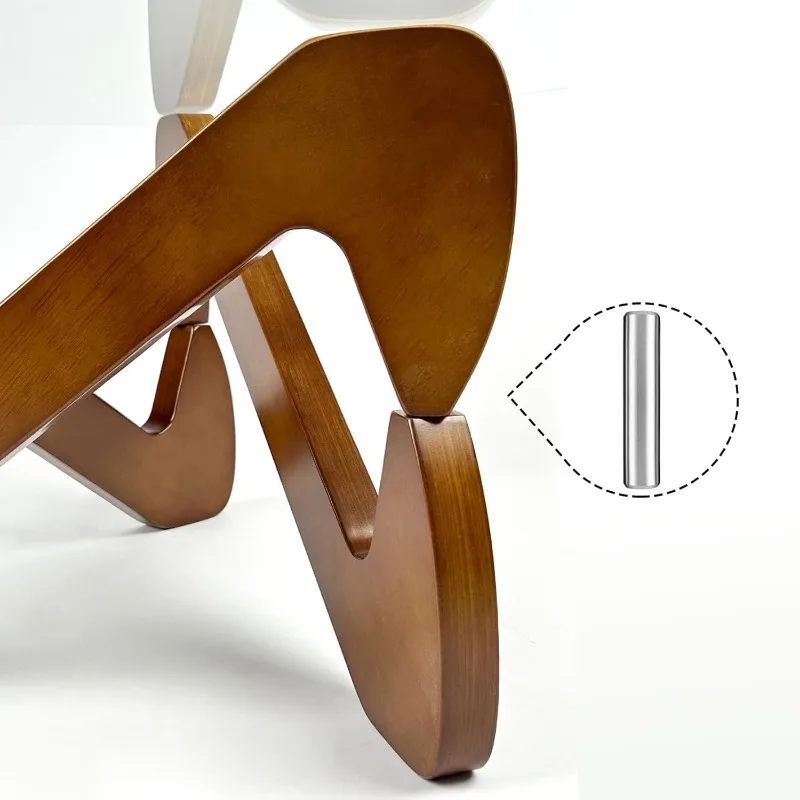
For flexible styling options throughout the year, consider nesting coffee tables that can be reconfigured as needs change.
Solutions for Common Glass Table Styling Challenges
Even design enthusiasts sometimes struggle with coffee table styling. Here are solutions to common challenges:
Challenge: “My table looks too empty or sparse.”
Solution: Rather than adding more items, try larger scale pieces or items with more visual weight. A substantial tray, larger art book, or one impressive sculptural object can fill space more effectively than several small items.
Challenge: “Everything slides around on the glass.”
Solution: Use discreet museum gel or putty under items to secure them in place without visible evidence. Alternatively, incorporate textured trays or mats that provide friction.
Challenge: “The styling looks cluttered despite minimal items.”
Solution: Evaluate the visual complexity of each piece. Sometimes fewer, simpler items create more impact than numerous detailed pieces. Group related items on trays to visually simplify the arrangement.
Challenge: “The glass surface shows every fingerprint and dust particle.”
Solution: Incorporate regular quick cleanings into your routine, and consider a thin, clear protective film designed for glass surfaces that resists fingerprints without changing appearance.
Challenge: “My arrangement lacks visual interest or cohesion.”
Solution: Ensure you’re varying heights, textures, and shapes while maintaining a cohesive color story or material theme. Sometimes one unexpected element—like an unusual vintage piece—adds personality.
Challenge: “The styling doesn’t look authentically mid-century.”
Solution: Research popular glass top coffee table designs from the era and note their styling in period photographs. Authentic mid-century spaces were practical and livable, not museum displays.
Personalizing Your Mid-Century Table Layout
While understanding design principles is important, your space should ultimately reflect your personality and lifestyle. The most successful mid-century interiors balance design integrity with personal expression.
Incorporate meaningful items by selecting pieces that align with mid-century aesthetic values while carrying personal significance. Family heirlooms, travel souvenirs, or hobby-related items can be integrated thoughtfully if you consider their form, color, and scale within your arrangement.
Non-conventional objects often make the most interesting coffee table accessories. A beautiful stone collected on a special trip, an unusual ceramic piece from a local artist, or a vintage camera can become conversation pieces while adding unique character to your styling.
As your collection grows, allow your arrangement to evolve organically. The beauty of mid-century design lies in its adaptability—it welcomes both vintage treasures and contemporary pieces as long as they share common design values. Exploring authentic vintage coffee tables can provide inspiration for integrating period pieces with modern elements.
At Hearth Forms, we believe the best interiors tell personal stories while honoring timeless design principles. Your glass top mid-century coffee table provides the perfect stage for that story—one that balances form and function in the true spirit of mid-century modern design.

